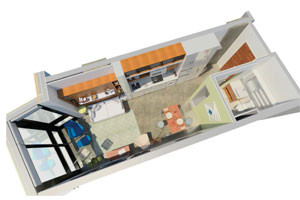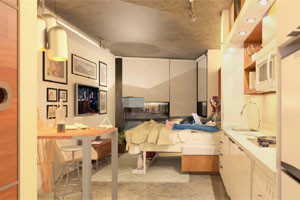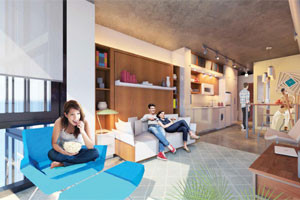WASHINGTON — The concept behind the “tiny house” trend, which transformed one Northeast D.C. alley into an exhibition of minimalism, is moving beyond the house and into the plans for many District real estate developers.
D.C. will soon see what it’s like to experience tiny living in an apartment.
The term “micro-unit” is being presented at Advisory Neighborhood Commission meetings and zoning hearings throughout the city. While the definition of a micro-unit varies from developer to developer, Mark Wellborn, co-founder of UrbanTurf, says the term generally applies to an apartment between 250 square feet and 375 square feet.
“Lots of people five years ago called those studio apartments, but the term ‘micro-unit’ has gotten really popular in the last three years,” Wellborn says. “Buzz is the operative word.”

D.C.’s changing demographics have a lot to do with the increased interest in, and building proposals for, these micro-units — and location is a major influencing factor.
Experts are taking note that young professionals want to be close to work and places of socialization, such as restaurants, bars, grocery stores, shops, parks and music venues.
“A number of our readers, we’re finding, prize location over space and don’t mind living in small spaces without a lot of stuff, as long as they’re in the neighborhood where they want to be,” Wellborn says.
That was the reason Sondra Dietz, 31, moved into a 325-square-foot apartment in the Cathedral Heights neighborhood of Northwest, D.C. in 2008.
At the time, Dietz worked for a D.C.-based public health nonprofit and attended graduate school. She didn’t want to live with anyone else, but still wanted to be in the city.
“I thought that I could do it, and with the built-in shelving and everything, it seemed like it would be able to accommodate all of my stuff,” says Dietz, who lived in the apartment for two years and paid around $1,250 a month for the space.
Dietz’s ability to find such a small apartment was rare five years ago, though.
David Versel, senior research associate at the George Mason University Center for Regional Analysis, says many young professionals who want to live in the city can’t afford a place that allows them to live alone, since there are not many micro-sized apartments currently on the rental market.

Traditional studios of 500 square feet to 600 square feet in high-demand areas cost around $2,000 a month. That’s why most single millennials who migrate to the District share an apartment with roommates or enter group houses.
“Young, single professionals want to live in the District in larger numbers than they have in recent memory, and at the same time … there are just no available options for people who want to live alone,” says Versel, who adds that developers are catching on to the fact that there is a whole side of the market that wants to live alone and can probably afford to do so for around $1,500 a month.
To meet that demand, developers are deciding to cut the square footage and make the units smaller and more affordable. The limited space shouldn’t be a problem for the target demographic.
“The good news is that millennials don’t want to hang out in their apartments and have big dinner parties. The apartment is just a place to come home at night and read a book and go to sleep. They spend most of their time either working or socializing outside of the home,” Versel says.
Aside from the demand for location, predictions for D.C.’s future job market also fuels the micro-unit trend.
According to Versel’s research, most of the job growth in D.C. will be for lower-wage jobs requiring fewer college degrees. Versel’s research also predicts the region will need 200,000 rental units by 2032 to accommodate residents with household earnings under $100,000 and with rent around $1,750 a month.

That price is about what developers predict for these micro-apartments.
As of now, new-construction micro-units in D.C.’s redeveloped neighborhoods are so new, they just exist on paper.
“Nothing has actually been built,” Urban Turf’s Wellborn says.
However, micro-unit projects are planned for The Wharf development in Southwest D.C., the Patterson Mansion in Dupont Circle and a building of apartments on the 1400 block of Church Street in Logan Circle.
Matt Steenhoek is the vice president of development at PN Hoffman Construction Development, part of the Hoffman-Madison Waterfront development team currently working on plans for The Wharf, an area sandwiched between the Maine Avenue Fish Market and Arena Stage along the Southwest D.C. waterfront.
The development includes approximately 170 micro-units that vary in square footage, but come in under 400 square feet. Larger apartments also are planned at The Wharf.
Steenhoek says the amenities planned for the area makes tiny apartment living more attractive to renters.
“You know, you have so much out your front door that you don’t need to pay the premium for more [space],” Steenhoek says.
In addition to its amenities, the soon-to-be-built micro-apartments include features that make living in a smaller space easier, such as a skinnier dishwasher, a combined washer-dryer and a convection microwave instead of a full oven.
Murphy beds, or beds that fold into the wall or into a couch, also are common space-savers in micro-units.
“It’s all of these little details that enable the space to get tighter and more efficient, but not lose any of its functionality,” Steenhoek says.
The micro-unit trend is not one that is limited to D.C.
Seattle, another city that has seen significant growth in the millennial population, is leading the way in small apartments.
“It’s a very recent phenomenon everywhere, and it’s something that’s born of the same factors in other places,” George Mason’s Versel says.
However, New York is not a part of the micro-unit buzz. Versel says that’s because New York City does not allow new units to be under 500 square feet.
“So the large supply of tiny apartments in New York were all pre-World War II … It sort of boomeranged. There was this demand in the early 20th century for tiny apartments, but New York and other cities regulated them out of existence,” he says.
Whether the trend will interest generations beyond the millennials is anyone’s guess.
“It’s hard to say, but it depends on what the next generation looks like, how many people will be in it, what their preferences will be,” Versel says.
Developers are taking precautions just in case the appeal of small living quickly fades. At The Wharf, which plans to start construction at the end of March, all of the micro-units adjoin other micro-units.
“If at some point in the future there’s no demand for them, they can knock the wall down between the two units and turn them into a standard one-bedroom unit,” Versel says.













